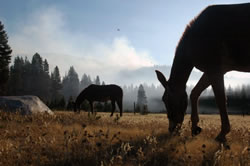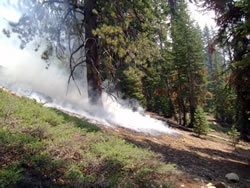
National Fire Plan Success Story
Horse Fire, Wilderness Response to a Wilderness Fire
Sequoia and Kings Canyon National Parks, California
National Fire Plan - Rehabilitation
2010

Fire behavior included creeping ground fire with isolated pockets of torching. NPS Photo.

Supplies for firefighters were brought in by stock. NPS photo by Brandon Dethlefs.
Sequoia and Kings Canyon National Parks have spent the past 80 years managing fires in the remote backcountry areas. When the Horse Fire ignited by lightning on July 19, 2009, park staff saw an opportunity to manage this fire similar to 1930s era wildland fire. Instead of relying on the park helicopter for transport, firefighters hiked twenty miles round-trip to the fire near Hockett Meadows.
As with all fires, staff made a determination on how to respond to the fire based on its location, potential for spread, and other variables. Due to its remote location, monitoring was the chosen strategy.
Firefighters hiked into the fire area for multiple-day assignments to assess and map fire growth. In total, fire crews hiked over 1,500 miles over the course of the summer and fall. They called in additional firefighters to assist with the protection of the historic Hockett Ranger Station as fire approached this cultural resource.
Adhering to the principles of the Wilderness Act, supplies and materials were brought in primarily by stock, with nine stock trips completed for the duration of the fire. Helicopter use was limited and no fireline was cut. The fire grew to 664 acres.
Naturally occurring fire allows forests to be thinned, opening the canopy and allowing sunlight through, which allows for the sprouting and re-growth of plants, shrubs and trees. Fire also allows for the recycling of nutrients to the soil while reducing the amount of dead, woody debris. Managed lightning fires limit the size and severity of subsequent fires.
“The Horse Fire is an excellent example of a lightning fire in the Wilderness that restores the natural fire cycle in the fire- adapted Sierra Nevada. I am proud that our response reflected the nature of a wilderness park,” said Dave Allen, Sequoia District Fire Management Officer.
Contact: Michelle Puckett, Fire Prevention / Education Technician, (559) 565-4287; Deb Schweizer, Fire Communication and Education Specialist, (559) 565-3703.